Death of Roger Cuvillier, father of the Pan Cinor zoom lens
By Marc Salomon, consulting member of the AFC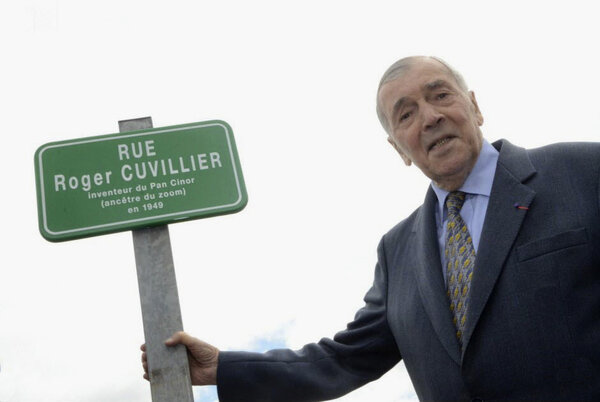
Roger Cuvillier died in Dijon on Monday, 14 January 2019 at the age of 97. He was born on 2 July 1922 in Lille. After graduating from the Ecole centrale and the Ecole supérieure d’optique, in 1947 he was hired by the SOM Berthiot Corporation, the famous manufacturer of “Cinor” lenses for 8 and 16mm cameras. One of his friends, Richard Cornu, a young filmmaker and a recent graduate of IDHEC, challenged him to replace the three lenses (15mm, 25mm and 75mm) on his Paillard - Bolex camera by a single lens that would continuously cover all of the focal lengths.
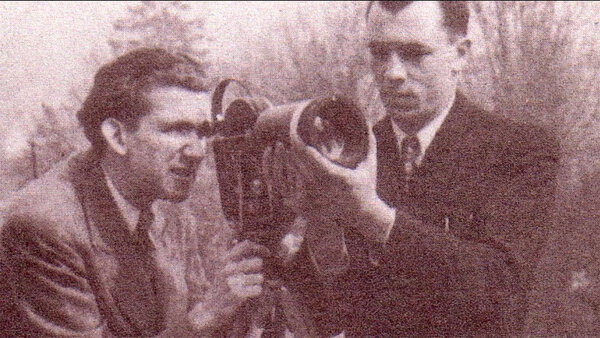
Starting in 1949, he began to concentrate on a problem that others before him had begun to answer in a more-or-less satisfying way : how to develop a variable-focus lens that would maintain brightness and focus throughout the focal range.
The argument about who should be awarded paternity of the variable-focus lens is still a subject of passionate debate today, one in which questions about lenses get mixed up with questions regarding national pride.*
Indeed, a first patent was registered in the United States in 1927 by Rolla T. Flora for an “afocal” mechanism that enabled a slight variation in the angle of view on a primary lens. Cameraman Joseph Walker registered a similar patent in 1933.
But it was English firm Taylor & Hobson which, in 1932, began to experience some success with its famous Cooke Varo-Lens 40-120mm, and which inaugurated the principle of mechanical compensation, but with a fixed focal length and an aperture that varied between f/3.5 and f/5.6 depending on the focal length. In Germany, the Astro Corporation began to market the Transfokator in 1935, an afocal system mounted on top of a 20mm Tachar lens for the 16mm format and on a 50mm lens for the 35mm format. In 1936, the Busch Corporation developed the 25-80mm Vario-Glaukar (f/2.8 – also with mechanical compensation) for Siemens 16mm cameras.
The 40-160mm f8 zoom lens created by Otto Durholz, and patented in 1934 in the United States is worth mention, despite its rudimentary nature, as is the 1947 Zoomar by Frank G. Back, designed for television cameras and later adapted to 16mm cameras (a 17-53mm lens with f/2.9 aperture).
One must recognize that the Pan Cinor was the first true technical and commercial success before the arrival of Angénieux zoom lenses, and even beyond. It is estimated that over 100,000 Pan Cinor zoom lenses were sold, all of them manufactured in Dijon until 1970 and sold throughout the world. Between 1949 and 1959, the company went from 80 to 700 employees in order to meet demand.
Starting in the 1950s, SOM Berthiot began to market a universal-mount 20-60mm f/2.8 Pan Cinor for 16mm cameras. All Pan Cinor zooms will be manufactured in the former Fleury-Hermagis factories in Dijon, which Roger Cuvillier managed from 1949 until his retirement.
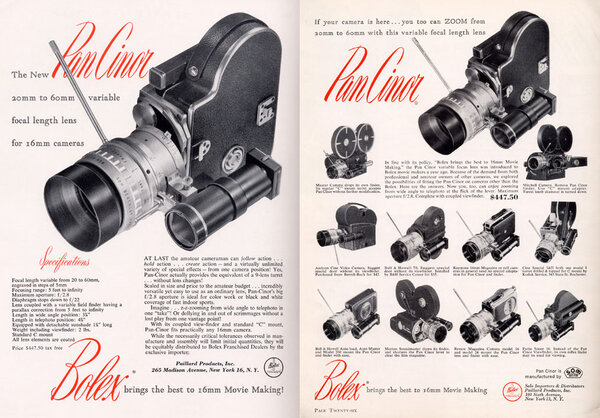
The Pan Cinor operated according to the principle of optical compensation, in which two lenses on a single lens assembly move simultaneously in the same direction inside of a tube in order to ensure the variation in the focal length while maintaining focus within acceptable tolerances : “The Pan-Cinor is, in my opinion, the first really usable variable-focal-length lens every created, but the zoom has made us forget this. The reason is simple, the focus oscillates from one side of the frame to the other when you change the focal length (gendarme-hat shaped curve)” (Pascal Martin)**
Roger Cuvillier described his invention to Pascal Martin in the following terms in 2002 : “I started from the afocal system used in binoculars, which are composed of a concave and a convex lens. By modifying the spacing of the lenses, I was able to obtain a variation in the magnification, but also in the focus, of the image. Using a graph, I was able to identify the variation that followed a curve presenting two rather symmetrical branches. So, I had the idea of putting two systems of this type end-to-end and noted that the magnifications increased and that I was able to obtain compensation of the variations in focus. That enabled me to design a composite system of four lenses, alternatively concave and convex, by ensuring that the two mobile convex lenses moved in sync with each other. Laboratory analyses showed that the system was valid, meaning it was able to maintain both focus and light in an image for a focal-length variation of up to 4 times magnification. Although the principle was sound, the image was quite mediocre, but luckily Raymond Rosier, the company’s optical engineer, was able to correct the main aberrations.”
The Pan Cinor was sold in a great many models (12.5-36mm and 10-30mm for 8mm format ; 17.5-70mm, 25-100mm, and 17-85mm for 16mm format, etc.).
Pierre Lhomme shot Chris Marker’s The Lovely Month of May with an Éclair “KMT” 16mm prototype camera equipped with a Pan-Cinor zoom lens in 1963. According to his memory, it was a 17.5-70mm lens.
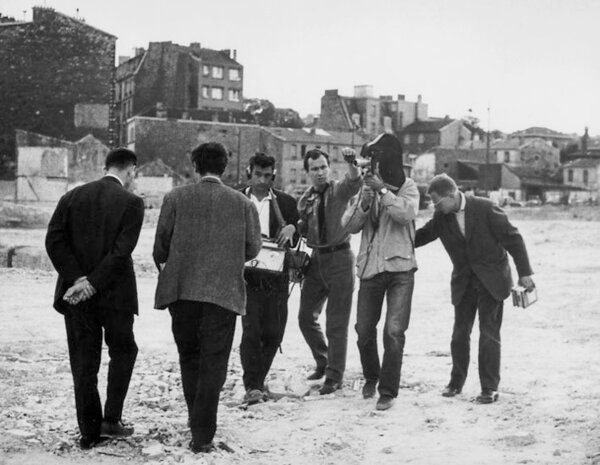
The 35mm (38.5-154mm f/3.8) cinema version was developed in 1954 and was mass-produced and marketed in September 1956. The professional press actually announced two zoom lenses with different apertures and focal lengths : f/2.4 / T3.5 from 4.5 meters to infinity and f/3.8 / T4.5 from 2 meters to infinity. This zoom lens was sold in the United States beginning in February 1957 and was available with a Mitchell mount the following year.
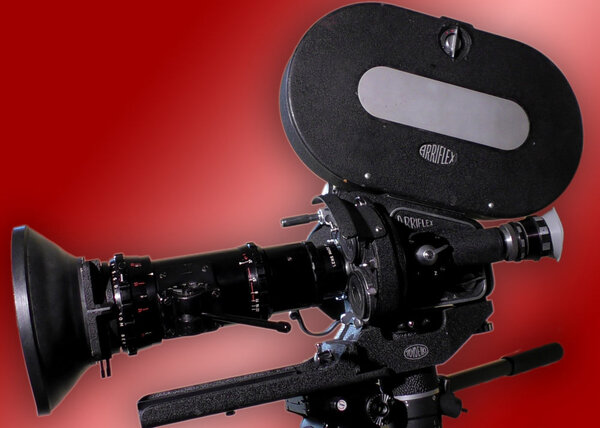
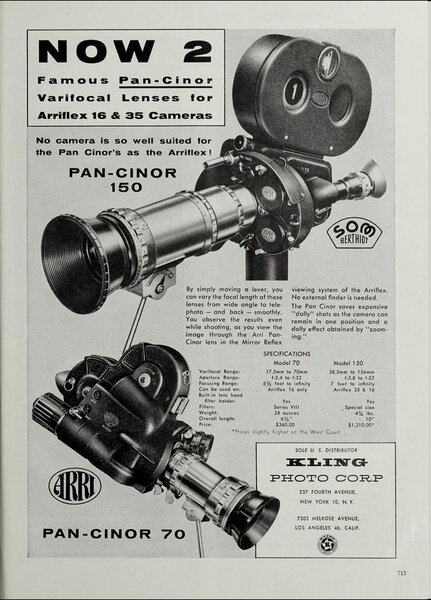
In France, cameraman Walter Wottitz tested this new Pan Cinor out on a few shots in Honoré de Marseille, by Maurice Régamy, with the opening credits even mentioning : “Pancinor S.O.M. Berthiot special effects” ! A zoom out effect is visible during the final scene of Montparnasse 19, by Jacques Becker, in 1957, when Gérard Philipe collapses in front of La Coupole, a film shot by Christian Matras who was still using the Pan Cinor on H.G. Clouzot’s Les Espions. Henri Alekan also used the Pan Cinor zoom lens on Jean Meyer’s The Would-Be Gentleman, in 1958.
Later on, Henri Decae used the Pan Cinor on a few shots in The 400 Blows (François Truffaut, 1959) and Jean Rabier used it on Cléo de 5 à 7 (Agnès Varda, 1962)***
Sold throughout the world, many uses of this zoom lens can be found in the United States, Germany, Italy, Hungary, India, etc.
The Pan Cinor 38.5-154mm was still available for rent from Chevereau in the late 1960s. But the competition from the Angénieux and later from Taylor & Hobson’s Cooke put an end to the Dijon brand.
Roger Cuvillier ended his interview with Roger Martin with the following words : “But, nonetheless, I want to denounce the misuse of my invention by some amateur filmmakers, which nearly make me regret having created it… Some rules must be followed in order to create visually pleasing effects, and one can rapidly learn them. Then, it’s a prodigious tool…”
We remind the reader that in 1958, the famous compensated zoom effects in Alfred Hitchcock’s Vertigo were only possible thanks to Roger Cuvillier and his Pan Cinor. A version of this zoom lens capable of covering the VistaVision format had been developed, it was a 60-240mm T5.9 lens presented at Photokina in 1956, at the same time as the 38.5-154mm.
* On this subject, see Priska Morrissey’s article, “Naissance et premiers usages du zoom” [Birth and early uses of the zoom lens”], published in Positif n°564, Feb. 2008.
** Pascal Martin is a university professor at the Laboratoire d’optique appliquée at the Ecole nationale supérieure Louis-Lumière. Roger Cuvillier’s words, cited between quotation marks, are excerpted from an interview he gave in 2002 which was published in Le Photographe, n°1593.
*** See “Entretiens avec Alain Levent et Ricardo Aronovich” [“Interviews with Alain Levent and Ricardo Aronovich”] by Priska Morrissey in Positif n°564, Feb. 2008.
- Interview with Roger Cuvillier in the attic of the photo museum Nicéphore Niépce in Saint-Loup de Varennes.
- Tribute to Roger Cuvillier (directed by Jean-Pierre Deschamps)
 En
En Fr
Fr




